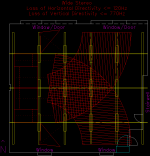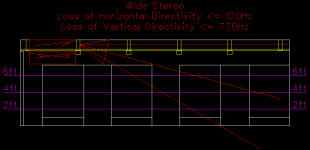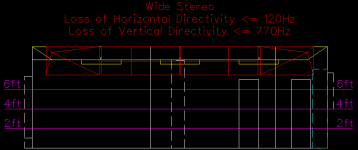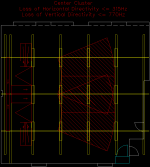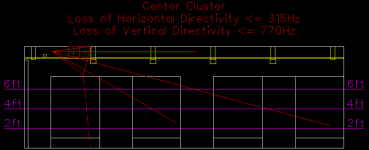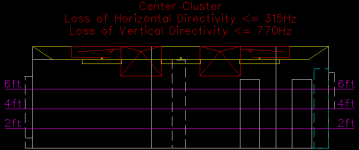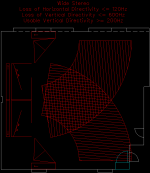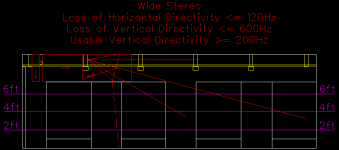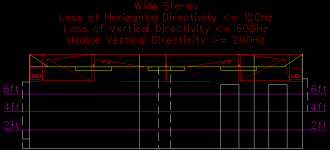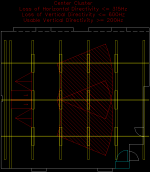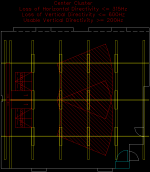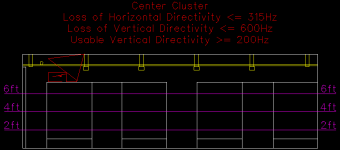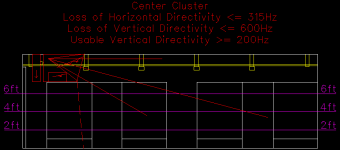My church was donated a small building a few months ago. Used to be a lawn & garden store, owned by the father of one of our members. We've been getting by in that space with a "cinder-block"-style powered mixer, and some old wedges on chairs as mains. (still way too low, but at least they're not on the floor) I'm working on getting a Behringer XR18 as a Front-of-House mixer like I did for our other location, and I've been thinking about a serious PA as well. We have spoken word, of course, and dreams of a full band. (so far, it's acoustic guitar, cajon, and a vocal or two, all plugged in) So here's what I've come up with so far.
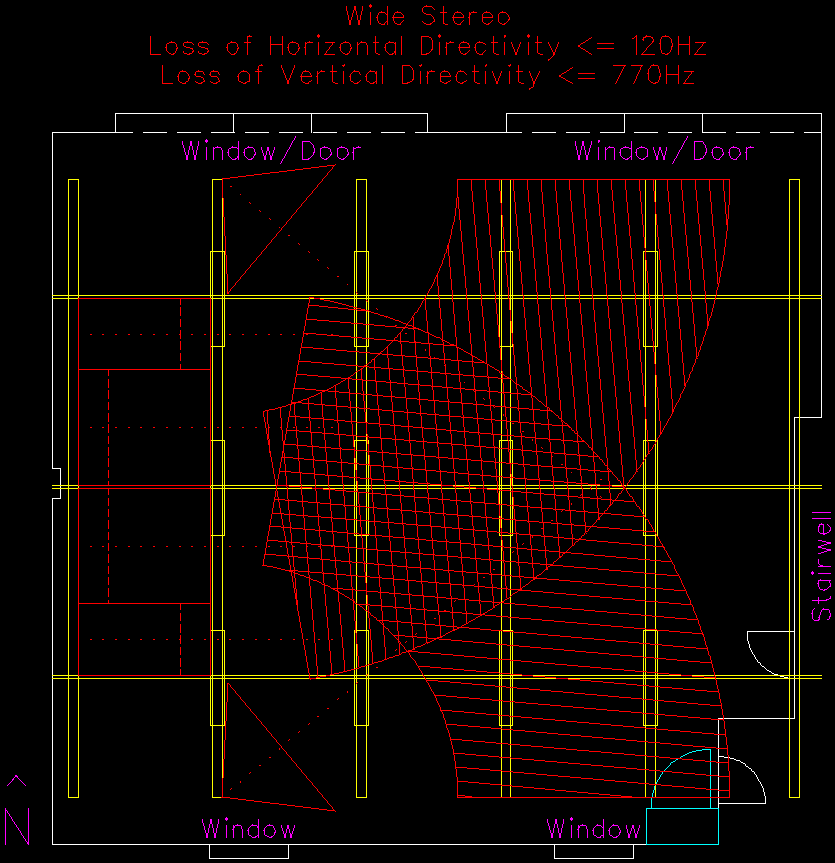
White is the room outline - approx. 32 feet East-West by 30 feet North-South, with a restroom at the lower-right.
Yellow is the steel-truss rafters and fluorescent lights mounted to them.
Blue is a free-standing closet.
Red is the speaker locations and estimated -3dB coverage pattern.
The tops, set wide and angled in, are from Bill Waslo's SynergyCalc spreadsheet, found here:
https://www.diyaudio.com/forums/members/bwaslo.html
80degH, 30degV, keep H to 120Hz - basically, maximum size to fit in the space with a 3-foot height allowance down from the 10.3-foot ceiling
The MidBass and Subs are two tapped-horns each, configured as a gradient array to try and keep them off of the stage directly beneath them.
Do-It-Yourself Cardioid Sub
Yes, I know the wide-set and angle-in means comb-filtering for center-panned stuff, but there are lots of other compromises going on here too (no space for a center channel, and how to manage it anyway?), and I do want to keep a stereo image for most of the audience. I doubt that most people would notice anyway. Hi-Fi enthusiast audiophiles, probably, but most people aren't that.
Here's a side-view:
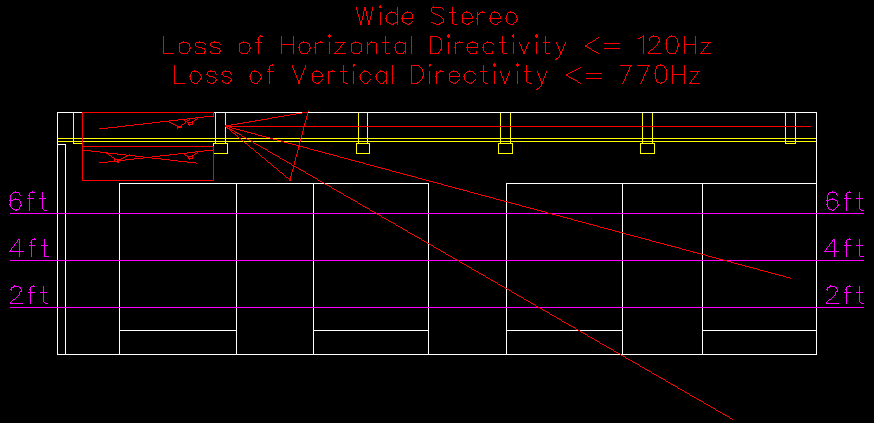
Note: The tops in this view are not aimed correctly in the horizontal plane. I left them straight to make it easier to estimate the coverage distance at 4 feet off the floor. (estimated sitting height)
The top of the coverage pattern is parallel to the corrugated steel ceiling in an attempt to approximate an array of two in free space.
I also understand that this is firing the tops through the truss, which is also a no-no for absolute best quality, but there's really no other place to put something this size. I hope they're far enough away to not matter too much?
Detail of the gradient arrays:
Left: 30-60Hz, Right: 60-120Hz, might be stretched some?


Overall height is ~3 feet to match the allowance that I gave myself.
Overall length is ~5.5 feet to match the space between rafters.
One of each has to fit in slightly less than 13 feet between the rafter stabilizers.
With 3-way tops per side (and considering active crossovers), and two LF boxes per side, each of which requires two unique signals of its own, that's a total of 14 amp channels minimum! So I'm thinking about using 7 Behringer NXxxxxD amps with a 7-way analog split per side and call it a day with the wiring. (or reduce it to a 4-way split with creative use of the Bi-Amp mode) Maybe mount them between the subs and the back wall, with enough USB hubs to cover them all and a single home-run USB cord for config and two XLR cords for L/R signals.
Here's the product page for the smallest one, which includes the free DSP config app, so you can poke around and see what they can do:
NX1000D | Portable | Power Amplifiers | Behringer | Categories | MUSIC Tribe
For reference, here's another view through the wall behind the stage:
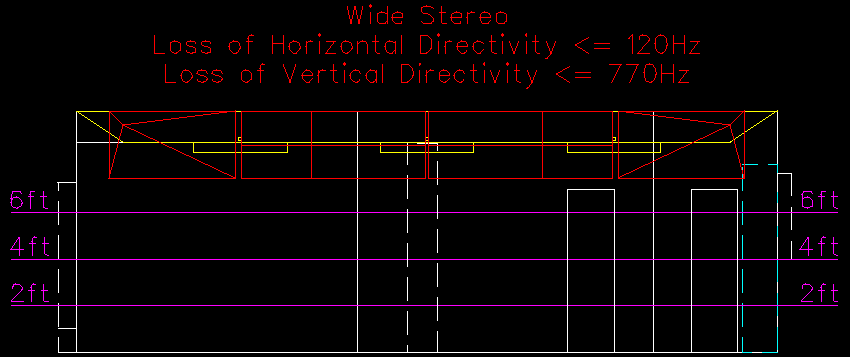
So, for those of you that made it all the way down here , are there any glaring errors or omissions? I haven't designed any more detail than what's shown here, like the selection and placement of drivers, the internal geometry of the TH's, exact crossover freqs and slopes, amp sizes, etc. I'd rather not waste time on that if even the top-level idea doesn't work.
, are there any glaring errors or omissions? I haven't designed any more detail than what's shown here, like the selection and placement of drivers, the internal geometry of the TH's, exact crossover freqs and slopes, amp sizes, etc. I'd rather not waste time on that if even the top-level idea doesn't work.
Edit:
We got a little bit off track discussing raw SPL. You can read that if you like, but we get back on about coverage patterns and smooth crossovers at post #17.
https://www.diyaudio.com/forums/pa-systems/334007-sanity-check-custom-installed-pa.html#post5706003
White is the room outline - approx. 32 feet East-West by 30 feet North-South, with a restroom at the lower-right.
Yellow is the steel-truss rafters and fluorescent lights mounted to them.
Blue is a free-standing closet.
Red is the speaker locations and estimated -3dB coverage pattern.
The tops, set wide and angled in, are from Bill Waslo's SynergyCalc spreadsheet, found here:
https://www.diyaudio.com/forums/members/bwaslo.html
80degH, 30degV, keep H to 120Hz - basically, maximum size to fit in the space with a 3-foot height allowance down from the 10.3-foot ceiling
The MidBass and Subs are two tapped-horns each, configured as a gradient array to try and keep them off of the stage directly beneath them.
Do-It-Yourself Cardioid Sub
Yes, I know the wide-set and angle-in means comb-filtering for center-panned stuff, but there are lots of other compromises going on here too (no space for a center channel, and how to manage it anyway?), and I do want to keep a stereo image for most of the audience. I doubt that most people would notice anyway. Hi-Fi enthusiast audiophiles, probably, but most people aren't that.
Here's a side-view:
Note: The tops in this view are not aimed correctly in the horizontal plane. I left them straight to make it easier to estimate the coverage distance at 4 feet off the floor. (estimated sitting height)
The top of the coverage pattern is parallel to the corrugated steel ceiling in an attempt to approximate an array of two in free space.
I also understand that this is firing the tops through the truss, which is also a no-no for absolute best quality, but there's really no other place to put something this size. I hope they're far enough away to not matter too much?
Detail of the gradient arrays:
Left: 30-60Hz, Right: 60-120Hz, might be stretched some?
Overall height is ~3 feet to match the allowance that I gave myself.
Overall length is ~5.5 feet to match the space between rafters.
One of each has to fit in slightly less than 13 feet between the rafter stabilizers.
With 3-way tops per side (and considering active crossovers), and two LF boxes per side, each of which requires two unique signals of its own, that's a total of 14 amp channels minimum! So I'm thinking about using 7 Behringer NXxxxxD amps with a 7-way analog split per side and call it a day with the wiring. (or reduce it to a 4-way split with creative use of the Bi-Amp mode) Maybe mount them between the subs and the back wall, with enough USB hubs to cover them all and a single home-run USB cord for config and two XLR cords for L/R signals.
Here's the product page for the smallest one, which includes the free DSP config app, so you can poke around and see what they can do:
NX1000D | Portable | Power Amplifiers | Behringer | Categories | MUSIC Tribe
For reference, here's another view through the wall behind the stage:
So, for those of you that made it all the way down here
Edit:
We got a little bit off track discussing raw SPL. You can read that if you like, but we get back on about coverage patterns and smooth crossovers at post #17.
https://www.diyaudio.com/forums/pa-systems/334007-sanity-check-custom-installed-pa.html#post5706003
Attachments
Last edited:
Hi Volunteer,
Sorry, but I think this would be way too much PA for a 960 ft^2 room, especially with the 10.3 ft ceiling. That's only just under 10,000 ft^3 and probably the only absorption in the space is the patrons -- or maybe them and some all-weather carpet.
I think you could achieve excellent coverage and intelligibility with a pair of Yamaha S115V's (or similar) and a couple hundred watts/side. Then at some future point when you add drums and bass guitar (and so have fundamentals below 150 Hz to render), consider adding a powered sub on each side. Excess volume will be a bigger challenge than not enough power.
Regarding the TH subs in a cardioid arrangement -- I admire your ambition (and budget!). But unless you plan to show THX movies or play the 1812 Overture, but there's really nothing for them to do! There are no signals that low; if there were, and you got even a fraction of those subs' potential out of them, it would be significantly more than churchgoers would find pleasing.
Stereo image, comb filtering, and -3 dB points can be disregarded. Unless you're playing material recorded in stereo, there is no stereo image. And unless the room is packed solid with people, the diffuse field will start about 8 ft from each main and it'll fill in the notches.
With a corrugated sheet steel and very low ceiling, open truss joists, and minimal absorption throughout, a distributed system might be a still better solution. Definitely better for spoken word; somewhat less satisfying for music. 12 to 16 smallish full-range drivers would give good coverage, and if you had a couple extra amp channels, put a little digital reverb on the last two rows of speakers to help the music.
This sure is some fine work you've presented; it'd be great in a much larger room -- and maybe one with no ceiling or back wall behind the stage.
And hey, if your Kansas City is the same as mine, maybe I could help directly -- I'm in the book.
Regards,
Rick
Sorry, but I think this would be way too much PA for a 960 ft^2 room, especially with the 10.3 ft ceiling. That's only just under 10,000 ft^3 and probably the only absorption in the space is the patrons -- or maybe them and some all-weather carpet.
I think you could achieve excellent coverage and intelligibility with a pair of Yamaha S115V's (or similar) and a couple hundred watts/side. Then at some future point when you add drums and bass guitar (and so have fundamentals below 150 Hz to render), consider adding a powered sub on each side. Excess volume will be a bigger challenge than not enough power.
Regarding the TH subs in a cardioid arrangement -- I admire your ambition (and budget!). But unless you plan to show THX movies or play the 1812 Overture, but there's really nothing for them to do! There are no signals that low; if there were, and you got even a fraction of those subs' potential out of them, it would be significantly more than churchgoers would find pleasing.
Stereo image, comb filtering, and -3 dB points can be disregarded. Unless you're playing material recorded in stereo, there is no stereo image. And unless the room is packed solid with people, the diffuse field will start about 8 ft from each main and it'll fill in the notches.
With a corrugated sheet steel and very low ceiling, open truss joists, and minimal absorption throughout, a distributed system might be a still better solution. Definitely better for spoken word; somewhat less satisfying for music. 12 to 16 smallish full-range drivers would give good coverage, and if you had a couple extra amp channels, put a little digital reverb on the last two rows of speakers to help the music.
This sure is some fine work you've presented; it'd be great in a much larger room -- and maybe one with no ceiling or back wall behind the stage.
And hey, if your Kansas City is the same as mine, maybe I could help directly -- I'm in the book.
Regards,
Rick
Last edited:
I don't see any reason your basic plan won't work assuming the speakers are to be installed aimed down at the listeners, and if the I beam directly in front of the tops produces reflections line or stuff the cavity of the beam directly in front of the speaker with sound absorbing materials.
However I think you're going way overboard with the speakers, the room is less than 1000sq ft and won't require big power so a 3 way system with a passive crossover between the mids and highs will be sufficient. 14 amp channels? No.. none of the live instruments you are supporting produce a stereo signal so this could be a done with 3 amp channels.. 5 at most for stereo mid-highs. No need for dual tuned subs either even a tapped horn will cover 2 octaves... or are you just itching to try out some of these designs? I think less is more when it comes to live sound support, there will be enough problems taming the room for good intelligibility so the less you have to work the system the better your chances of a good result.
However I think you're going way overboard with the speakers, the room is less than 1000sq ft and won't require big power so a 3 way system with a passive crossover between the mids and highs will be sufficient. 14 amp channels? No.. none of the live instruments you are supporting produce a stereo signal so this could be a done with 3 amp channels.. 5 at most for stereo mid-highs. No need for dual tuned subs either even a tapped horn will cover 2 octaves... or are you just itching to try out some of these designs? I think less is more when it comes to live sound support, there will be enough problems taming the room for good intelligibility so the less you have to work the system the better your chances of a good result.
Last edited:
Wow, I like the advice here, esp the point about stereo image. Difficult to achieve even in the best of circumstances, ad no-one really notices the lack of image, IMO. Intelligibility matters much more, IMO.
I left another thread where I was being piled on because I felt that several thousand watts of power in small club to provide headroom was overkill. I suggested distributed sound system, using inexpensive speakers and basically was told that would not work.
I left another thread where I was being piled on because I felt that several thousand watts of power in small club to provide headroom was overkill. I suggested distributed sound system, using inexpensive speakers and basically was told that would not work.
Okay, so I have three responses so far saying, "It's way too big!" At first glance, I completely agree; these boxes are HUGE! However, the primary purpose for that size is not SPL, but pattern control.
The lower you want to keep control, the physically bigger they have to be. And I REALLY want to keep it off of the stage! (FEEDBACK!!!!) The present design promises to keep the Synergies in charge all the way down to a reasonable highpass frequency for the vocal mics, which I expect to be directly under the front of the subs or slightly in front.
Yes, we do have hard surfaces all around, but the pastor mentioned a barnwood front wall (back of the stage), so I'll tell him to exaggerate the difference in height between panels to try and make a diffuser. I'm also looking at creating a fuzzy back wall, and maybe side walls too.
As for covering the full audio range, we might not have that content yet, but we do have visions of a full band. I've mixed a 5-string bass guitar before, and it was AWESOME! He was low enough to be out of everyone else's way, so I could really crank him! 5-string basses typically bottom out around 31Hz. I've never had a system that went that low though, except for that bassist's own amp, which I used as an aux'ed subwoofer for that gig because the main subs were pathetic anyway. I suspect that actually covering that fundamental would result in not actually turning him up as much as I would otherwise.
The reason to split the subs into 1 octave each is not for the tapped horn, but for the gradient/cardioid array. Too low, and they blend into a single driver with rapidly diminishing efficiency. Too high, and they start lobing/comb-filtering. So the array itself pretty much dictates a 1-octave range, regardless of what its component drivers actually are. (or so I understand at the moment)
The lower you want to keep control, the physically bigger they have to be. And I REALLY want to keep it off of the stage! (FEEDBACK!!!!) The present design promises to keep the Synergies in charge all the way down to a reasonable highpass frequency for the vocal mics, which I expect to be directly under the front of the subs or slightly in front.
Yes, we do have hard surfaces all around, but the pastor mentioned a barnwood front wall (back of the stage), so I'll tell him to exaggerate the difference in height between panels to try and make a diffuser. I'm also looking at creating a fuzzy back wall, and maybe side walls too.
As for covering the full audio range, we might not have that content yet, but we do have visions of a full band. I've mixed a 5-string bass guitar before, and it was AWESOME! He was low enough to be out of everyone else's way, so I could really crank him! 5-string basses typically bottom out around 31Hz. I've never had a system that went that low though, except for that bassist's own amp, which I used as an aux'ed subwoofer for that gig because the main subs were pathetic anyway. I suspect that actually covering that fundamental would result in not actually turning him up as much as I would otherwise.
The reason to split the subs into 1 octave each is not for the tapped horn, but for the gradient/cardioid array. Too low, and they blend into a single driver with rapidly diminishing efficiency. Too high, and they start lobing/comb-filtering. So the array itself pretty much dictates a 1-octave range, regardless of what its component drivers actually are. (or so I understand at the moment)
Interestingly enough, my first design for this room actually *was* a three-row set of stereo delay speakers, all identical Synergies. It would have been driven mostly in mono, since they were pointed straight back with minimal overlap. The estimated coverage of that was even better than what I presented here, but I was intimidated by that many separate hangs, even before I added subs. (and then I went on to design this one  )
)
The other problem was if I now had roughly constant volume across the entire room, I couldn't imagine that a single sub up front would keep up all the way back. (or would be too loud up front if it matched further back) And it pretty much had to be up front because it would be horribly out of time anywhere else because of the delays.
Time-arrayed subs too? Maybe, but at that point, I think a single source up front would be simpler, hence the present design. I've heard outdoor systems with delay towers that I could hear from stage. It was awful. Unless each delayed sub was cardioid itself, it seems that it would basically be that again.
I also thought about creating a plane source over the entire ceiling with no delays, but quickly realized that it only works if the *entire* ceiling is involved. So I can't keep it off the stage that way. Sure, I could delete those drivers, but the drop-off just isn't sharp enough like the Synergies promise.
Plane-array of Synergies? Maybe, but again, that's a lot of speakers, all of which have to be custom made. We do have a woodshop in the basement of that building, and a guy that knows how to run it, but still...
The other problem was if I now had roughly constant volume across the entire room, I couldn't imagine that a single sub up front would keep up all the way back. (or would be too loud up front if it matched further back) And it pretty much had to be up front because it would be horribly out of time anywhere else because of the delays.
Time-arrayed subs too? Maybe, but at that point, I think a single source up front would be simpler, hence the present design. I've heard outdoor systems with delay towers that I could hear from stage. It was awful. Unless each delayed sub was cardioid itself, it seems that it would basically be that again.
I also thought about creating a plane source over the entire ceiling with no delays, but quickly realized that it only works if the *entire* ceiling is involved. So I can't keep it off the stage that way. Sure, I could delete those drivers, but the drop-off just isn't sharp enough like the Synergies promise.
Plane-array of Synergies? Maybe, but again, that's a lot of speakers, all of which have to be custom made. We do have a woodshop in the basement of that building, and a guy that knows how to run it, but still...
Following that design, I had a pair of Synergies about where the subs are now, still aimed straight back to be driven mostly in mono with minimal overlap. But then I thought about sub placement again. Compared to the size of the tops, I didn't think I had enough space left between the outer stabilizers to match them well, so I thought about putting the subs outboard.
No, that's too far apart. Power alley. So I put the subs in the center and the tops outboard to come up with post #1 here.
No, that's too far apart. Power alley. So I put the subs in the center and the tops outboard to come up with post #1 here.
Last edited:
You may have a select audience volunteering out of your main church congregation, but I rather doubt a church audience likes that much sound. I'm covering a 30'x25' brick wall sanctuary with two speakers 30" off the floor up front, 10" woofers, 3" tweeters and one capacitor as crossover, in a sealed box. 100 W/ch. The richest old guy complained about too much bass when I had Peavey 1210's in there with dual 10" woofers, so I replaced one woofer in the current speakers (KLH23) with a low sound level dayton. Now he likes it. The voice is pre-existing bose line array on the ceiling in the middle, four 4" drivers it looks like, and about a 60W PA hub/CD player. I have to keep the music speakers cut way down to not drown out the voice. Volume is adequate and not enough to drive off the elders. Many of us in church audiences still have our OEM hearing. I do, due to training in use of ear plugs in the Army when I was 18. I find 95 db quite exciting, I don't need 120. Men who have ruined their ears with power equipment firearms stage monitors etc excepted, but they are probably not listening anyway. usually are not music fans.
With bass guitar you may need a sub at some point, but I still think your power needs are < 100 W. Sub can go anywhere, the wavelength of sub frequencies is longer than your building. Speaking of breaking up standing waves, more effort might go into a suspended sound panel ceiling and hanging fabric on one or more walls. Not as fun as electronics, but a deader room makes the word/vocals more intelligible IMHO.
With bass guitar you may need a sub at some point, but I still think your power needs are < 100 W. Sub can go anywhere, the wavelength of sub frequencies is longer than your building. Speaking of breaking up standing waves, more effort might go into a suspended sound panel ceiling and hanging fabric on one or more walls. Not as fun as electronics, but a deader room makes the word/vocals more intelligible IMHO.
Last edited:
"hanging fabric on one or more walls."
No. Spend the money on sound dispersion devices - buy them or make them - there are lots of designs on the web. Fabric dampens sound unevenly across the frequency range, and makes EQ that much more difficult.
However, I agree with indianjo that the PA is supposed to be about sound reinforcement, and most operators running sound systems and "artists" run the sound way too high. Protect your hearing, and design and operate for intelligibility. That is sane sound reinforcement, IMO.
No. Spend the money on sound dispersion devices - buy them or make them - there are lots of designs on the web. Fabric dampens sound unevenly across the frequency range, and makes EQ that much more difficult.
However, I agree with indianjo that the PA is supposed to be about sound reinforcement, and most operators running sound systems and "artists" run the sound way too high. Protect your hearing, and design and operate for intelligibility. That is sane sound reinforcement, IMO.
Having seen lots of churches under-spec their sound systems (basically, play a commercially-produced CD when they're in a calm mood and declare an absolute max from that), I've come to the conclusion that a system really needs to be grossly overkill at first glance to be about right in actual practice. Not that you're going to use anywhere near that much on a given day, but my reasons are:
1. Tuning takes headroom. EQ boosts, lousy efficiency at certain points because of other trade-offs, etc.
2. Transients take headroom. Drum hits, guitar picking, etc. You don't get that from a commercial CD because it's all been squashed in the production process. With live music, you still have it, and that's what makes it feel live. It's quite surprising how tall some of those spikes can be.
(Vocals loudest? Nope! Drums loudest. Look at the LED peak meter. They don't sound like they're that high, but they do peak there. And the vocal is still crystal clear.)
3. Special effects take headroom. Most of the time, we don't need an electronic thunderstorm, earthquake, etc., but when we do, we do.
4. Other uses take headroom. An "old folks" service might be just fine with a single mic for a leader to sing acapella, and that's only for the back row while the front gets it directly. But for a youth group, it needs to be loud. (but not overly so) On a different system, I found that clean-lyric metal that matches their yelling volume seems about right for a game of dodgeball to get their energy out, with a ducker for the MC so the total volume never goes above that.
And there's also something to be said about a concert feel, where it's loud enough to be difficult to talk to your neighbor, but mixed well enough on a clean system to not realize that until you try. I've heard people say that they explicitly want that because they want to sing but don't want to embarrass themselves next to their neighbors. Yes, it's loud, but not painful at all because of the good mix, good system, and good acoustics.
5. Clean/undistorted sound takes headroom. If you push something to the limit of what it can do, it'll distort *before* it gets there. It's still getting louder, even at the fundamental frequencies, but it's already adding harmonics. But overkill-going-easy stays clean.
Putting all of that together means that the system will probably be more than capable of breaking anyone's ears well before it even notices, and so it requires discipline from the engineer running it. Don't just crank it and take what comes as a definition of "good" because it's a "good" system, but design it the whole way through. Turn it up *when it needs that*, and *back down again* when it doesn't. Always have an answer for WHY it needs to be loud *right now*. If not, don't.
Understanding that, and also understanding that untrained people will still have to use it, we'll also have a small analog mixer in addition to the XR18. The XR remains solely in charge of the PA at all times, and the analog/public console feeds the XR. The XR, then, has limiters on those input channels, and all other channels are muted. So anyone can "play music", "plug in a mic", etc., but only those that have had the training or are otherwise trusted may use its full capability.
For acoustic treatment, I'm rather impressed with this:
YouTube
Basically, a stack of towels blocked more sound than packing foam, commercial acoustic foam, or a pillow, when placed between a speaker and a mic. Sure, it's not the same as a speaker and mic on the same side, with the panel against a hard wall; but if the theory is correct that sound must travel through the panel, reflect off the wall, and then back through the panel again, then maybe it's not so bad of a test after all. And of course, the universal rule still applies, that it only works for small wavelengths compared to the thickness of the panel.
And it's also sight-unseen in an edited video. You can do all kinds of magic with that. So what do you guys think of it?
For what it's worth, I have a pair of KLH SX-8's (200W-rated passive 3-way) in my home system with a 2x100W amp behind them. They do a pretty good job as full-range mains in my home system. No sub. I'm actually surprised how little I have to do with the 30-band graphic EQ that I put in; a Dayton EMM-6 reference mic and some tone bursts show that they're almost flat already at my listening position. But as often and as high as I turn them up just for me, I wouldn't dream of using them for an audience. (I also keep a meter handy: even when I turn them up, I'm still below OSHA's chart)
1. Tuning takes headroom. EQ boosts, lousy efficiency at certain points because of other trade-offs, etc.
2. Transients take headroom. Drum hits, guitar picking, etc. You don't get that from a commercial CD because it's all been squashed in the production process. With live music, you still have it, and that's what makes it feel live. It's quite surprising how tall some of those spikes can be.
(Vocals loudest? Nope! Drums loudest. Look at the LED peak meter. They don't sound like they're that high, but they do peak there. And the vocal is still crystal clear.)
3. Special effects take headroom. Most of the time, we don't need an electronic thunderstorm, earthquake, etc., but when we do, we do.
4. Other uses take headroom. An "old folks" service might be just fine with a single mic for a leader to sing acapella, and that's only for the back row while the front gets it directly. But for a youth group, it needs to be loud. (but not overly so) On a different system, I found that clean-lyric metal that matches their yelling volume seems about right for a game of dodgeball to get their energy out, with a ducker for the MC so the total volume never goes above that.
And there's also something to be said about a concert feel, where it's loud enough to be difficult to talk to your neighbor, but mixed well enough on a clean system to not realize that until you try. I've heard people say that they explicitly want that because they want to sing but don't want to embarrass themselves next to their neighbors. Yes, it's loud, but not painful at all because of the good mix, good system, and good acoustics.
5. Clean/undistorted sound takes headroom. If you push something to the limit of what it can do, it'll distort *before* it gets there. It's still getting louder, even at the fundamental frequencies, but it's already adding harmonics. But overkill-going-easy stays clean.
Putting all of that together means that the system will probably be more than capable of breaking anyone's ears well before it even notices, and so it requires discipline from the engineer running it. Don't just crank it and take what comes as a definition of "good" because it's a "good" system, but design it the whole way through. Turn it up *when it needs that*, and *back down again* when it doesn't. Always have an answer for WHY it needs to be loud *right now*. If not, don't.
Understanding that, and also understanding that untrained people will still have to use it, we'll also have a small analog mixer in addition to the XR18. The XR remains solely in charge of the PA at all times, and the analog/public console feeds the XR. The XR, then, has limiters on those input channels, and all other channels are muted. So anyone can "play music", "plug in a mic", etc., but only those that have had the training or are otherwise trusted may use its full capability.
For acoustic treatment, I'm rather impressed with this:
YouTube
Basically, a stack of towels blocked more sound than packing foam, commercial acoustic foam, or a pillow, when placed between a speaker and a mic. Sure, it's not the same as a speaker and mic on the same side, with the panel against a hard wall; but if the theory is correct that sound must travel through the panel, reflect off the wall, and then back through the panel again, then maybe it's not so bad of a test after all. And of course, the universal rule still applies, that it only works for small wavelengths compared to the thickness of the panel.
And it's also sight-unseen in an edited video. You can do all kinds of magic with that. So what do you guys think of it?
For what it's worth, I have a pair of KLH SX-8's (200W-rated passive 3-way) in my home system with a 2x100W amp behind them. They do a pretty good job as full-range mains in my home system. No sub. I'm actually surprised how little I have to do with the 30-band graphic EQ that I put in; a Dayton EMM-6 reference mic and some tone bursts show that they're almost flat already at my listening position. But as often and as high as I turn them up just for me, I wouldn't dream of using them for an audience. (I also keep a meter handy: even when I turn them up, I'm still below OSHA's chart)
In a 23' X 30' space, are you saying that you need to mike the drums? That is just the kind of nonsense that the "sound reinforcement" industry wants so that you do have to buy a lot of power and speakers to move the air.
How do you explain that in the 20s and 30s, the acoustic big band in those ballrooms could be heard? The vocalist was typically the only one being miked. How do explain those small jazz clubs, where there was no sound reinforcement. You think the patrons could not hear them?
And before the advent of distributed sound being the norm in huge concert halls, are you saying that patrons in such halls as Carnegie, Symphony Hall in Boston, and the Academy of Music in Philadelphia were straining to hear the unamplified music? Or what about chamber groups in smaller halls and rooms?
The problem these days if you've got two generations of people who have not gone to a music event in a room and heard unamplified music. Clearly in an outdoor situation, the need for reinforcement and gobs of power is unquestioned. But your room is a relatively small room.
How do you explain that in the 20s and 30s, the acoustic big band in those ballrooms could be heard? The vocalist was typically the only one being miked. How do explain those small jazz clubs, where there was no sound reinforcement. You think the patrons could not hear them?
And before the advent of distributed sound being the norm in huge concert halls, are you saying that patrons in such halls as Carnegie, Symphony Hall in Boston, and the Academy of Music in Philadelphia were straining to hear the unamplified music? Or what about chamber groups in smaller halls and rooms?
The problem these days if you've got two generations of people who have not gone to a music event in a room and heard unamplified music. Clearly in an outdoor situation, the need for reinforcement and gobs of power is unquestioned. But your room is a relatively small room.
In a 23' X 30' space, are you saying that you need to mike the drums? That is just the kind of nonsense that the "sound reinforcement" industry wants so that you do have to buy a lot of power and speakers to move the air.
I do drop a mic inside the cajon when I have a spare. No stand, just let it sit in the bottom. EQ for "boom" and "click". I also want to mic the Djembe because I just can't hear it from the FOH position at our other venue. I don't think the rest of my mix is particularly loud either. I follow the mood, not religiously to a meter, but I do check the meter on occasion just to see if my ears are still calibrated. Mid 80's are common, sometimes low 90's, but I've also gone down to low 70's for live music when it fit the mood. (this is all with just an acoustic guitar and cajon - adding a fuzzy electric and bass, for an upbeat celebratory song, will likely go higher) Speaking is low-threshold-limited with makeup gain to stay at 70dBA (slow) regardless of our pastor's animated style. (quite often, he beats the limiter on his own, and that's okay, but he still needs the mic for the whispering parts)
Taking that and other experiences to the new location (which presently requires the FOH position to be on the front row because of an analog powered mixer - the X-Air will solve that part), I already have the same problem of not hearing the percussion. (he also doesn't play very loud, which is the opposite problem that most people have with a full kit - I've been there too, and it's not fun)
How do you explain that in the 20s and 30s, the acoustic big band in those ballrooms could be heard? The vocalist was typically the only one being miked. How do explain those small jazz clubs, where there was no sound reinforcement. You think the patrons could not hear them?
They weren't always. The patrons had to be polite and respectful of the band if they wanted to hear them. Sometimes they were, and sometimes they weren't. A bit later, The Beatles weren't always heard in concert because of their screaming fans.
And before the advent of distributed sound being the norm in huge concert halls, are you saying that patrons in such halls as Carnegie, Symphony Hall in Boston, and the Academy of Music in Philadelphia were straining to hear the unamplified music? Or what about chamber groups in smaller halls and rooms?
Those rooms are designed at great expense for their acoustic properties. Originally because there was no other option, and in modern times because it still sounds awesome. And the patrons still have to be polite to make it work. We don't have that; we're a former lawn & garden store, with kids.
The problem these days if you've got two generations of people who have not gone to a music event in a room and heard unamplified music. Clearly in an outdoor situation, the need for reinforcement and gobs of power is unquestioned. But your room is a relatively small room.
And there are popular instruments now that require amplification to work at all. Electric and bass guitars, for example. And the musicians' skill to accurately mix themselves from stage is simply non-existent now, or even impossible given that the audience PA is intentionally designed to not hit the stage. Whatever does "leak" is nowhere near accurate to what the audience hears. Sure, a professional orchestra can still do it, but they don't have to worry about feedback and so their venue can be designed for them to hear too. And even so, they have a conductor that not only provides a common timebase, but also fills the role of "FOH Engineer" for this all-acoustic endeavor by instructing certain adjustments during rehearsal or between performances.
All in all, I think I know where you're coming from, and it's good to go back there every once in a while, but since we're talking about Church, have a look at Psalm 150, which includes a list of popular instruments at the time in poetic fashion. A quick study of what they were and their combined sound suggests something not far off from a modern rock concert. And that's not the only passage to encourage excited worship and praise to the Creator. (okay, enough sermon - it's a secular site, and you get the idea)
So I do want enough SPL to overcome screaming kids, provide/allow for excitement during live music, make a shy singer comfortable enough to open up, etc. My purpose in asking is more to do with 1) balance and intelligibility *at that SPL*, whether from a single driver or across multiple drivers, wherever they might be located, and 2) the ability to hit the audience really well and the stage hardly at all for the purpose of preventing feedback. (directional PA for the same reason as directional mics)
If you're peaking at 95 db, you have at least some sense. Cajon was not a popular instrument until they started miking drums; it is not nearly as loud inherently as a snare drum.
If you tune your room with a graphic equalizer and have an 18 input mixer, be prepared to walk in some night and discover all the toys gone: pawned in the next city across the state line. We minister to the lost after all. My 2 way mains speakers have a pawn shop value of $10, would go for a magnificant $25 at Goodwill. The 100 W amps are screwed inside the organ, are a **** to get out. And the 8 channel mixer I'm preparing to boost my wimpy voice when I sing over the piano, it will be hidden inside the organ too. The master volume will be the organ swell pedal, a stealth PA device if you ever saw one. We allow the do-less in the church two nights a week for a free meal, and several days in a row when the weather is below 15 F. Some of the clients are pleasant and just a little skillless, others are petty thieves when they get a chance.
Whereas if you tune your room with a soft ceiling, foam blocks and sound treatment, you can't give that stuff away on garbage day. It goes from the curb to the compacter truck directly.
Do lock your good mikes up in the safe. We do.
If you tune your room with a graphic equalizer and have an 18 input mixer, be prepared to walk in some night and discover all the toys gone: pawned in the next city across the state line. We minister to the lost after all. My 2 way mains speakers have a pawn shop value of $10, would go for a magnificant $25 at Goodwill. The 100 W amps are screwed inside the organ, are a **** to get out. And the 8 channel mixer I'm preparing to boost my wimpy voice when I sing over the piano, it will be hidden inside the organ too. The master volume will be the organ swell pedal, a stealth PA device if you ever saw one. We allow the do-less in the church two nights a week for a free meal, and several days in a row when the weather is below 15 F. Some of the clients are pleasant and just a little skillless, others are petty thieves when they get a chance.
Whereas if you tune your room with a soft ceiling, foam blocks and sound treatment, you can't give that stuff away on garbage day. It goes from the curb to the compacter truck directly.
Do lock your good mikes up in the safe. We do.
@Volunteer SoundGuy:
I see your point on the inability of many musicians to properly control their amps and their volume controls so that there is an overall mix of sound and they properly turn up and turn down their instruments for solos or accents. Seeing those concert films of guitar gods (Clapton, Hendrix, Beck, Page, Harrison and so on) properly controlling their instruments volume is so amazing and inspiring.
I also see your point about having to compete with the worshipers, which is part of the service.
You are very nice about stating your views; I am sorry for my apparent snarkiness.
I will leave with one other note: I've been watching old YouTube videos of acoustic groups in small venues, and I am correct in my recollection that performer's monitors were almost never used. The use of these monitors in inappropriate settings (i.e., other than huge concerts and at every outdoor gig) greatly expands the possibility of feedback - year another headache for the PA operator to have to deal with.
I see your point on the inability of many musicians to properly control their amps and their volume controls so that there is an overall mix of sound and they properly turn up and turn down their instruments for solos or accents. Seeing those concert films of guitar gods (Clapton, Hendrix, Beck, Page, Harrison and so on) properly controlling their instruments volume is so amazing and inspiring.
I also see your point about having to compete with the worshipers, which is part of the service.
You are very nice about stating your views; I am sorry for my apparent snarkiness.
I will leave with one other note: I've been watching old YouTube videos of acoustic groups in small venues, and I am correct in my recollection that performer's monitors were almost never used. The use of these monitors in inappropriate settings (i.e., other than huge concerts and at every outdoor gig) greatly expands the possibility of feedback - year another headache for the PA operator to have to deal with.
Well, its both:
The "artists" ask for sound that is too loud, for possible two reasons: (i) they don't know any better as that is what they have experienced all their lives; and/or (ii) they implicitly know that with loud sounds and the PA distorting (although they would not call it distortion), mistakes will be covered up and lack of technique will not be evident.
The operators who know better are tired of fighting with the artists who keep asking to "turn it up." The operators who don't know better are like the artists that have no experience with sound reinforcement that can be not ear-cringing but articulate, accurate and dynamic.
I've gravitated to performances indoors where there is little or no sound reinforcement, and they have always been great. I have also been to venues where there is a lot of sound reinforcement, with enough power appropriate for the room, multiple speakers, and the full array of processing equipment, and yet the sound is absolutely wonderful, not ear-bleeding, and one can hear all kinds of details: Barns at Wolf Trap, Ram's Head in Annapolis MD, the Birchmere in Northern Virginia. These are all different sizes, yet the operators are professionals who make the sound support the nation-class and world-class artists.
I certainly am not at that level of operator and will never be. No shame to say that, it is just a fact.
The "artists" ask for sound that is too loud, for possible two reasons: (i) they don't know any better as that is what they have experienced all their lives; and/or (ii) they implicitly know that with loud sounds and the PA distorting (although they would not call it distortion), mistakes will be covered up and lack of technique will not be evident.
The operators who know better are tired of fighting with the artists who keep asking to "turn it up." The operators who don't know better are like the artists that have no experience with sound reinforcement that can be not ear-cringing but articulate, accurate and dynamic.
I've gravitated to performances indoors where there is little or no sound reinforcement, and they have always been great. I have also been to venues where there is a lot of sound reinforcement, with enough power appropriate for the room, multiple speakers, and the full array of processing equipment, and yet the sound is absolutely wonderful, not ear-bleeding, and one can hear all kinds of details: Barns at Wolf Trap, Ram's Head in Annapolis MD, the Birchmere in Northern Virginia. These are all different sizes, yet the operators are professionals who make the sound support the nation-class and world-class artists.
I certainly am not at that level of operator and will never be. No shame to say that, it is just a fact.
If you're peaking at 95 db, you have at least some sense.
And good point about security. We're thinking about that too, but I think our resident carpenter can handle it. Custom rack, custom speakers with over-engineered fly gear, etc. Good luck getting any of this stuff out!
Anyway, I thought about it some more, and of course, I found some problems, mostly in the sub arrays:
1. The upper sub array (60-120Hz) was actually aimed *up* towards the ceiling, not out towards the audience. That's going to reflect off the ceiling and wrap around the lower front corner, not cancelled, and get on stage anyway. So I have to rethink that.
2. The distance between elements in both arrays was wrong. Ideally, it needs to be 1/4-wave at the upper crossover, with a 1/4-wave delay for the rear element, and the overall efficiency drops from there at about 6dB/octave as the phase angles become more equal and opposite polarity. (an octave above that - 1/2-wave spacing with 1/2-wave delay and polarity flip - becomes toroid, with the rear null copied to the front) Specifically, I need to shrink both arrays to make them closer together, while keeping the elements themselves large enough to stay at least somewhat efficient on their own.
3. I looked some more at TH design, and of course, my estimations for that were way off as well. Horns typically work best at 1/2-wave or longer, but the TH design helps to smooth out that bottom octave so that a 1/4-wave horn can still be good. So now I need to figure out how to get a 1/4-wave 30Hz horn in there...
4. I had completely forgotten about a drain pipe for the roof that runs all the way across the stage, right where I wanted to put the subs! I'm okay with moving the electrical conduit and maybe some light fixtures (but only if I have to), but that drain should probably stay where it is!
(it's not leaking at the moment, and I don't want it to start; plus it already looks like the minimum grade to ensure drainage, and anything I do will only reduce it)
So I went back to a previous design, which had two tops aimed straight back about center-ish over the stage, then put some (still guesswork, but closer than before) upper subs just outboard from them. Crossover around 200Hz because of the tops' 36" vertical mouth. (tops are aimed down about 15deg, and I really want to cross over before the physically-mandated widening-out reaches absolute vertical) Cardioid array again, but closer to each other and more in-line with the intended firing direction. Not sure whether to aim the front one out towards the audience and use its side wall as the distance between elements, or to aim them both down. (with a mouth that is itself comparable to 1/4-wave, how is that distance measured anyway? centers? near edges?)
I haven't figured out what to do with the lower subs yet. The best I've come up with so far is a complex folded TH (just to make it fit) firing towards the audience, filling the space inboard of the tops, and a mostly-straight TH (one 180-deg bend like the upper subs) behind everything to complete the cardioid array.
What I don't like about this is that the lower crossover point also reaches across an unrelated driver. Maybe that doesn't matter as much as I think it does (looking at roughly 60Hz or so, with a 50" horn mouth in between that does practically nothing at that frequency), but I really like the previous concept of having every crossover step between immediately adjacent sources.
I could invert the previous design entirely, having the tops exactly in the center and step outwards at lower frequencies, but the position shown here is dictated by the existing light fixtures, and not having the tops fire through one. Again, I might be able to move the lights (replace that center one with two attached to the lower edges of the subs?), but I'd rather not if I don't have to. And of course, there's still the problem of making everything fit around each other and the building.
Attachments
Okay, here's a slight paradigm shift. Relaxing the requirement that the two elements in a cardioid array must be identical, allows this:
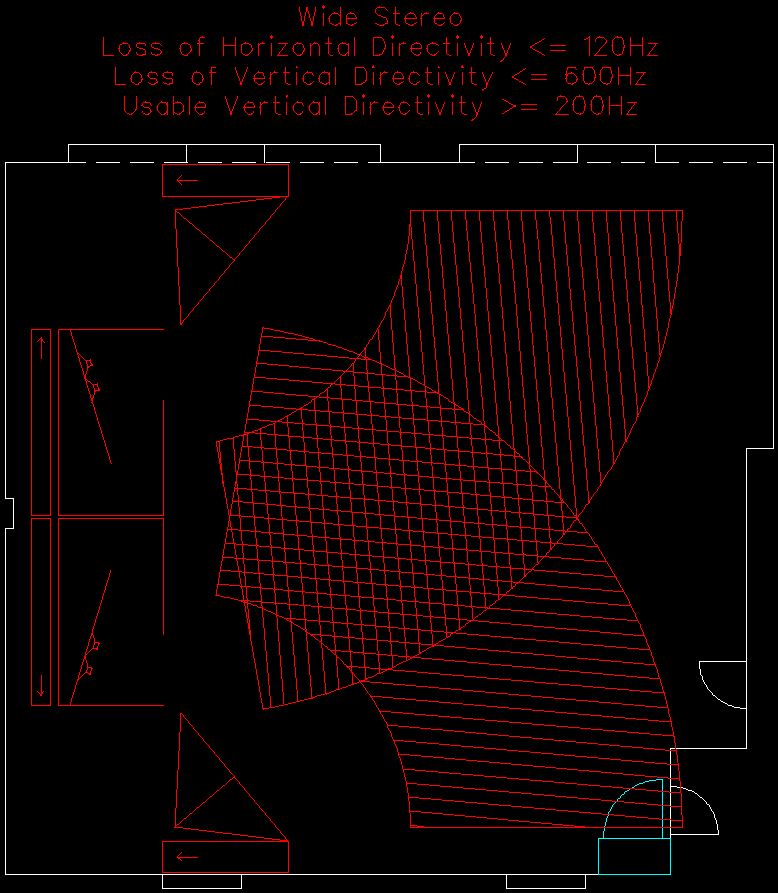
Rafters and drain pipe omitted for clarity. You've seen them before, and they haven't moved.
That's the same Synergy tops as the first time, in the same locations, but allowed to play down to about 80Hz or so, knowing that they'll become practically toroidal at that point. (vertical omni already, and horizontal getting there) So what used to be my MidBass array is now just the rear element, that fades in as the Synergies' pattern widens out to hit the stage. (~55" between centers) Thus, I'm only constrained by one mouth instead of two, and that allows me to put them completely out of the way of anything else. An ideal cardioid would require that mouth to be directly behind the main horn, and a single-fold TH just happens to fit exactly right there, between the tops and the side walls.
This also gives me an extra SPL boost from that side wall, as if I really needed one. Oh well, less amplifier power I guess.
Now the subs can fill the entire space between the tops, with a correspondingly large mouth, and allows for a 1/4-wave single-fold horn at 20Hz! That's a pleasant surprise. Then I put the rear element of that array behind the drain pipe, firing down.
(Of course, I don't *have* to fill all of my available space. I just did by default to show the maximum size that things can be.)
Other views:
Detail of the MidBass:

And in context:
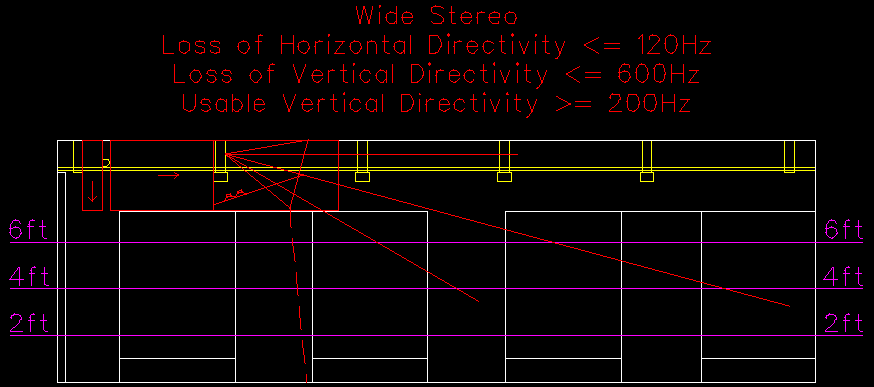
Like at first, the tops are not aimed correctly in this view. I left them straight to better estimate the floor coverage.
The red dashed line is the vertical pattern at 200Hz from a 36" mouth.
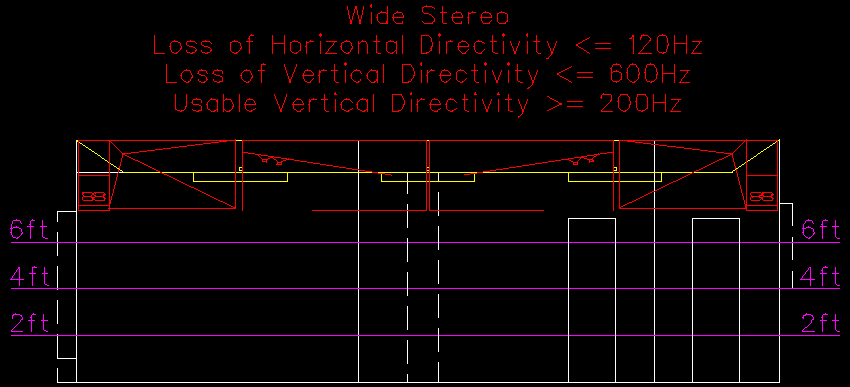
Only the rear elements of the sub array are shown here. They're 10" wide to fit between the drain and the near rafter, but the mouth is still 36" the other way to match the front elements, which themselves have 36" square mouths to match the height of the tops.
(something tells me I might have over-subbed it compared to the tops...)
Any other problems?
Is it workable to have two differently-designed elements in a cardioid array? Or will the inherent differences in response cause problems that can't be solved with relative EQ and such?
Is it workable to have not only different drivers, but a much wider frequency range for the front one? The front is designed to be directional on its own, and the rear is only to catch the spill below the controllable frequency.
Are the overall dimensions of each driver okay? I haven't designed the internal geometry yet; I'm mostly concerned now with overall fit between boxes and architectural features. If it's *possible* to get a smooth full-range sound in the audience from the arrangement shown, including a much quieter stage at all frequencies, then I'll lock down the external design and start looking at internal, but if the external doesn't even work, then there's not much point in looking at the details.
Of course, there will also be some acoustic treatment. I just haven't gotten to that point yet. I'd like to keep as much sound off the walls as I can in the first place, and *then* fuzz them. In fact, there are several places where (I think) I'm actually using a hard surface to my advantage. (all against the ceiling, for example)
Rafters and drain pipe omitted for clarity. You've seen them before, and they haven't moved.
That's the same Synergy tops as the first time, in the same locations, but allowed to play down to about 80Hz or so, knowing that they'll become practically toroidal at that point. (vertical omni already, and horizontal getting there) So what used to be my MidBass array is now just the rear element, that fades in as the Synergies' pattern widens out to hit the stage. (~55" between centers) Thus, I'm only constrained by one mouth instead of two, and that allows me to put them completely out of the way of anything else. An ideal cardioid would require that mouth to be directly behind the main horn, and a single-fold TH just happens to fit exactly right there, between the tops and the side walls.
This also gives me an extra SPL boost from that side wall, as if I really needed one. Oh well, less amplifier power I guess.
Now the subs can fill the entire space between the tops, with a correspondingly large mouth, and allows for a 1/4-wave single-fold horn at 20Hz! That's a pleasant surprise. Then I put the rear element of that array behind the drain pipe, firing down.
(Of course, I don't *have* to fill all of my available space. I just did by default to show the maximum size that things can be.)
Other views:
Detail of the MidBass:
And in context:
Like at first, the tops are not aimed correctly in this view. I left them straight to better estimate the floor coverage.
The red dashed line is the vertical pattern at 200Hz from a 36" mouth.
Only the rear elements of the sub array are shown here. They're 10" wide to fit between the drain and the near rafter, but the mouth is still 36" the other way to match the front elements, which themselves have 36" square mouths to match the height of the tops.
(something tells me I might have over-subbed it compared to the tops...)
Any other problems?
Is it workable to have two differently-designed elements in a cardioid array? Or will the inherent differences in response cause problems that can't be solved with relative EQ and such?
Is it workable to have not only different drivers, but a much wider frequency range for the front one? The front is designed to be directional on its own, and the rear is only to catch the spill below the controllable frequency.
Are the overall dimensions of each driver okay? I haven't designed the internal geometry yet; I'm mostly concerned now with overall fit between boxes and architectural features. If it's *possible* to get a smooth full-range sound in the audience from the arrangement shown, including a much quieter stage at all frequencies, then I'll lock down the external design and start looking at internal, but if the external doesn't even work, then there's not much point in looking at the details.
Of course, there will also be some acoustic treatment. I just haven't gotten to that point yet. I'd like to keep as much sound off the walls as I can in the first place, and *then* fuzz them. In fact, there are several places where (I think) I'm actually using a hard surface to my advantage. (all against the ceiling, for example)
Attachments
Okay, I think I got it now...or at least the overall idea. It's amazing how far off you get when you can't see the space that you're designing for. Sunday morning came and I got to see it again...ohh.
So here's something a little more sensible. Not that the other designs wouldn't have worked, but...anyway, here it is:
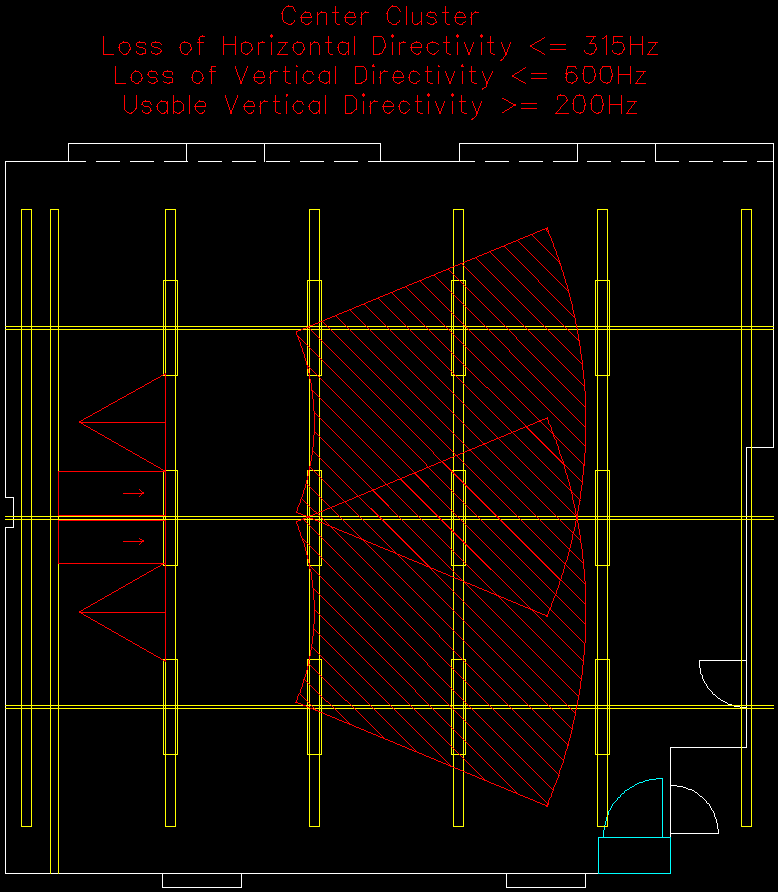
That's just the audience-facing speakers. Two Synergy clones between existing light fixtures, crossed over to a pair of TH subs around 80Hz or so. The TH's continue down to 30Hz minimum to cover the bottom fundamental of a 5-string bass.
The top horns are 50"H x 36"V x 44"D for a coverage pattern of 45degH x 30degV, and angled 15deg down to set the top of the pattern parallel to the hard ceiling.
The subs are inboard of that, as two units because of the rafter stabilizer in the center, but they'll sum to mono anyway, being closer than 1/4-wave to each other. 22"H x 36"V x 54"D maximum for each.
The estimated coverage pattern is at sitting level, and excludes the front row or two. That's okay because they'll hear a spoken word directly and don't need reinforcement. Standing for music will cover the center of the front rows, but I might need to add some corner fills. But since I'm thinking of them as add-ons anyway, I figure I can build this and then measure what's still needed over there.
Here's all of it:
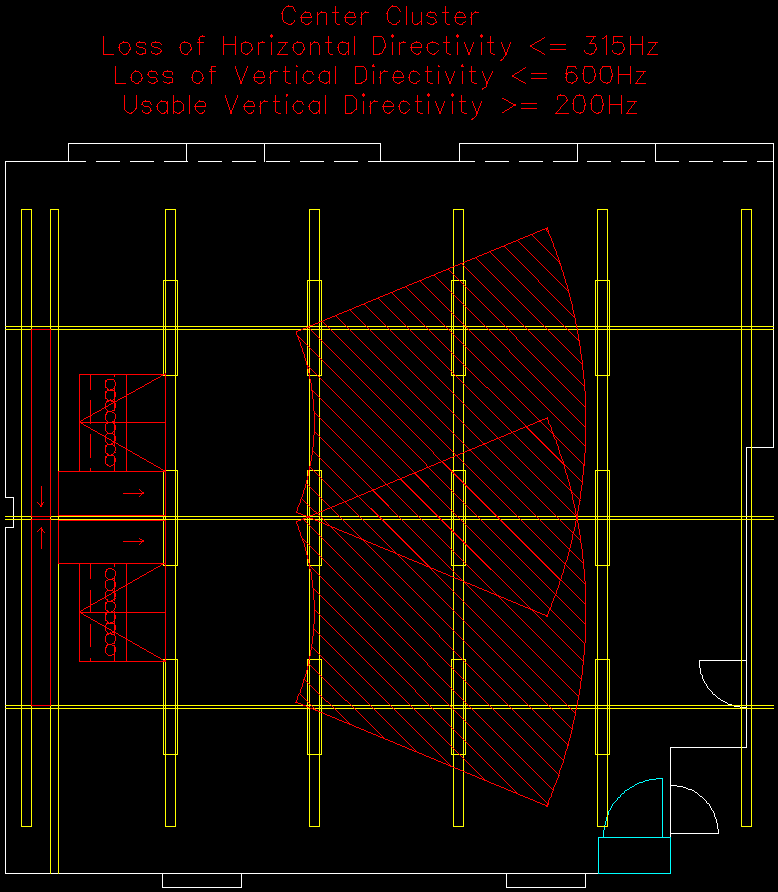
Cardioid subwoofers as before, but they don't need to be as big as I've had them before. The rear elements of that array have the entire space to themselves behind the drain pipe.
The top horns are designed for 45degH x 30degV and angled down about 15deg, but of course that doesn't help the natural widening-out at lower frequencies. So I tucked a small TH under each to fade into a cardioid array at the lower end. (I'll probably end up with fewer larger drivers in it, but whatever. It's just a quick conceptual drawing.) Here's a side view that shows the arrangement between them and the top horns:

Detail of the small cardioid supplement (left) and the main sub (right):


The lip in front of the small TH is a closed baffle to meet the mouth of the main horn. That distance on its own is about 15", or 1/4-wave around 230Hz or so. According to Keele's Constant, the main horn approaches absolute vertical around 200Hz, so I think I have a little bit of wiggle room...if I've measured the spacing correctly. Including half of the 6" mouth of the small TH brings the 1/4-wave frequency down to about 190Hz. Including half of the 36" tall main horn as well, brings it down to about 95Hz.
The mouth of the main sub is angled down 15deg to match the top horns, and I'm wondering about flipping it vertically so that the final centerline points downish instead of up as shown here. Like before, I haven't done a whole lot of work yet on the internal geometry.
I'm also thinking to create a false ceiling and a front wall to cover the entire volume over the stage so that:
- The rear cardioid elements are simply openings in that ceiling.
- The front elements are openings in the 15deg front wall of that box.
Complete side view:
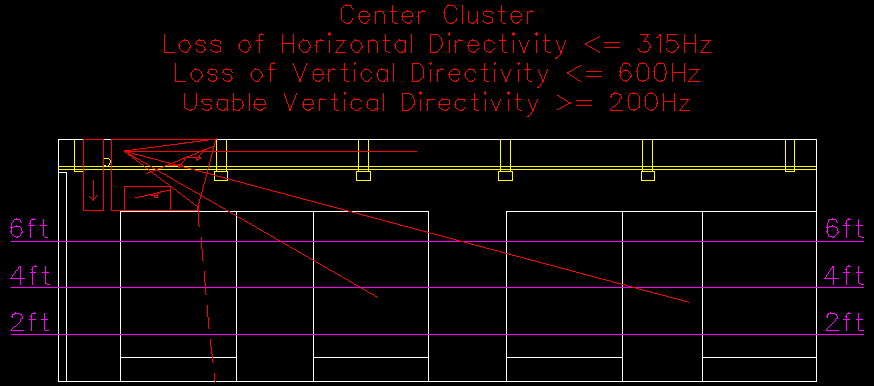
So the front few rows for music (standing) are going to be louder than the rest, with a fade down from there towards the back. Oh well. It's a difficult room, and I think I'll cause more problems than I solve if I try to fix that.
Besides, I've seen churches publish their measured coverage pattern so that those who want it loud can sit where it's loud, those who want it quiet can sit where it's quiet, and those who complain can be told to sit "over there" instead. So this not-completely-even coverage might actually be used to our advantage.
Anyone care to comment before I spend a ton of time designing internal stuff?
So here's something a little more sensible. Not that the other designs wouldn't have worked, but...anyway, here it is:
That's just the audience-facing speakers. Two Synergy clones between existing light fixtures, crossed over to a pair of TH subs around 80Hz or so. The TH's continue down to 30Hz minimum to cover the bottom fundamental of a 5-string bass.
The top horns are 50"H x 36"V x 44"D for a coverage pattern of 45degH x 30degV, and angled 15deg down to set the top of the pattern parallel to the hard ceiling.
The subs are inboard of that, as two units because of the rafter stabilizer in the center, but they'll sum to mono anyway, being closer than 1/4-wave to each other. 22"H x 36"V x 54"D maximum for each.
The estimated coverage pattern is at sitting level, and excludes the front row or two. That's okay because they'll hear a spoken word directly and don't need reinforcement. Standing for music will cover the center of the front rows, but I might need to add some corner fills. But since I'm thinking of them as add-ons anyway, I figure I can build this and then measure what's still needed over there.
Here's all of it:
Cardioid subwoofers as before, but they don't need to be as big as I've had them before. The rear elements of that array have the entire space to themselves behind the drain pipe.
The top horns are designed for 45degH x 30degV and angled down about 15deg, but of course that doesn't help the natural widening-out at lower frequencies. So I tucked a small TH under each to fade into a cardioid array at the lower end. (I'll probably end up with fewer larger drivers in it, but whatever. It's just a quick conceptual drawing.) Here's a side view that shows the arrangement between them and the top horns:
Detail of the small cardioid supplement (left) and the main sub (right):
The lip in front of the small TH is a closed baffle to meet the mouth of the main horn. That distance on its own is about 15", or 1/4-wave around 230Hz or so. According to Keele's Constant, the main horn approaches absolute vertical around 200Hz, so I think I have a little bit of wiggle room...if I've measured the spacing correctly. Including half of the 6" mouth of the small TH brings the 1/4-wave frequency down to about 190Hz. Including half of the 36" tall main horn as well, brings it down to about 95Hz.
The mouth of the main sub is angled down 15deg to match the top horns, and I'm wondering about flipping it vertically so that the final centerline points downish instead of up as shown here. Like before, I haven't done a whole lot of work yet on the internal geometry.
I'm also thinking to create a false ceiling and a front wall to cover the entire volume over the stage so that:
- The rear cardioid elements are simply openings in that ceiling.
- The front elements are openings in the 15deg front wall of that box.
Complete side view:
So the front few rows for music (standing) are going to be louder than the rest, with a fade down from there towards the back. Oh well. It's a difficult room, and I think I'll cause more problems than I solve if I try to fix that.
Besides, I've seen churches publish their measured coverage pattern so that those who want it loud can sit where it's loud, those who want it quiet can sit where it's quiet, and those who complain can be told to sit "over there" instead. So this not-completely-even coverage might actually be used to our advantage.
Anyone care to comment before I spend a ton of time designing internal stuff?
Attachments
- Status
- This old topic is closed. If you want to reopen this topic, contact a moderator using the "Report Post" button.
- Home
- Live Sound
- PA Systems
- Sanity Check - Custom Installed PA for Small Room
